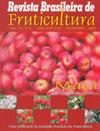桔梗早期选育,以耐缺氧为目标
IF 0.9
4区 农林科学
Q4 HORTICULTURE
引用次数: 0
摘要
基于Cupuassu (Theobroma grandflorum)的农林复合系统(AFS)可用于水源(河流、溪流、湖泊等)的泉水和河岸林周围植被的恢复。本工作的目的是研究洪水发生时形态生理性状之间的关系,确定最重要的基因型耐受性评估,并评估cupuassu基因型表达替代表型和生长效率的能力,以便选择能够维持缺氧条件的材料。试验在温室中进行,采用完全随机设计,采用16 × 2(16个子代和两个水制度)因子方案,并进行4次重复。幼苗移植后6个月开始处理。测定了15个与营养发育、生物量积累和生理有关的性状进行试验评价。通过估算相关系数和主成分来研究各性状之间的相互关系,确定最重要的性状以辅助后代选择。结果表明,在评价性状中,10个性状足以解释群体内的变异,4个性状被选为与选择最优后代最相关的性状。75%的基因型表现出对部分淹水的耐受性,基于性能和可塑性,我们选择了G174、G48和G56作为更广泛的基因型,而G44、G47和G51仅用于缺氧条件。这里指出的有希望的证据需要通过现场试验来证实,以便在缺氧环境的恢复中推荐cupuassu树。本文章由计算机程序翻译,如有差异,请以英文原文为准。
Early selection in Theobroma grandiflorum, aiming at tolerance to hypoxia
Abstract Cupuassu (Theobroma grandiflorum)-based agroforestry system (AFS) can be used for restoration of vegetation around springs and riparian forests of water sources (rivers, streams, lakes etc.), subject to constant flooding. The objectives of this work were to study the relations between morphophysiological traits when flooding occurs, determining the most important to assess genotypes’ tolerance, and evaluate the ability of cupuassu genotypes to express alternative phenotypes and grow efficiently, in order to select materials capable of sustaining hypoxic conditions. The trial was carried out in a greenhouse, in a completely randomized design with a 16 x 2 (16 progenies and two water regimes) factorial scheme and four replications. Treatments started six months after the seedlings were transplanted. 15 traits related to vegetative development, biomass accumulation and physiology were measured for the experimental evaluation. Correlations and principal components were estimated to study the traits’ interrelationships and identify the most important to assist progeny selection. The results revealed that, among the evaluated traits, ten were sufficient to explain the variability within the population and four were elected as the most relevant to select the best progenies. 75% of the genotypes showed tolerance to partial flooding and based on performance and plasticity, we selected G174, G48 and G56 for a broader spectrum and G44, G47 and G51 for hypoxic conditions only. The promising evidence pointed out here will need to be corroborated with field tests, so that the cupuassu tree can be recommended in the recovery of environments subject to hypoxia.
求助全文
通过发布文献求助,成功后即可免费获取论文全文。
去求助
来源期刊
CiteScore
1.50
自引率
20.00%
发文量
34
审稿时长
4-8 weeks
期刊介绍:
The Revista Brasileira de Fruticultura (RBF) publishes technical articles and scientific communications in the area of fruit crops, referring to results of original searches and unpublished papers in Portuguese, Spanish or English, and 1 or 2 reviews per edition, of invited authors.

 求助内容:
求助内容: 应助结果提醒方式:
应助结果提醒方式:


